IP-based Production and Broadcasting Network
The IP-based production and broadcasting network uses a technical architecture that is based on ICT as well as IP rather than the traditional SDI. After IP-based transformation, traditional and new media can be integrated to implement information interaction and multi-screen display, addressing the shortcomings of traditional media. In addition, new technologies such as virtualization, cloudification, and AI can be fully utilized to share resources, enhance collaboration, draw on Internet experience, and make technological breakthroughs.
Huawei's Intelligent IP Production and Broadcasting Network Solution uses the software defined networking (SDN) architecture, replaces the traditional SDI matrix with the IP-based switching matrix that uses the spine-leaf networking architecture. This solution also uses key technologies such as multicast NAT, clean switching, and high-precision clock to implement E2E network path planning and media signal scheduling.
Overview of the IP-based Production and Broadcasting Network
What Is a Production and Broadcasting Network?
- Ingesting refers to conducting interviews and collecting materials — it is a means of obtaining TV program materials. The materials may be produced by the TV station itself, for example, recordings taken in a television studio or at an outdoor location, or those taken by a news reporter conducting an interview. The materials may also be obtained from another TV station, for example, through satellite broadcast, or from tapes or CD-ROMs (such as those containing documentaries).
- Editing refers to a series of work conducted based on collected materials, including image editing, audio mixing and synthesis, and finished video review. Editing is an important part of content production by TV stations. Take an interview program as an example. If the camera focuses on the interviewer or interviewee for too long, the audience may become bored. In this case, you can insert other images to keep the audience interested — for example, you can insert a picture of an object being discussed during the interview. This is called image editing. In addition, you may also need to record narration, add pad music, and combine them into one soundtrack. This is called audio mixing and synthesis. Finally, you can add subtitles and special effects as required, and you can check whether the image is correct and whether the effect is satisfactory. This is called finished video review.
- Broadcasting means that TV content is broadcast through media, including live broadcast, rebroadcast, and catch-up TV. Take a football game as an example. Live broadcast refers to the playback of images in synchronization with the game. Rebroadcast refers to the playback of programs from another TV station. And catch-up TV refers to the playback of recorded images after the game ends. Among them, live broadcast requires producing and broadcasting at the same time, significantly testing the capabilities of TV stations.
- Storage refers to the online, nearline, or offline backup and storage of broadcast TV content in the local media asset management system. The TV content that will be broadcast recently is stored online, the TV content that will not be broadcast in the recent future is stored nearline, and the TV content to be put in tapes or CD-ROMs is stored offline permanently.
- Transmission refers to the transmission and dissemination of TV content. Some content is transmitted from a ground station to a satellite, then forwarded to another ground station, and finally transmitted to a local TV station for rebroadcasting. Other content is transmitted to carriers and broadcast through IPTV. Content can also be transmitted to the broadcasting and television cable network and broadcast through cable TV.
Put simply, TV content production and broadcasting is a complex system project, involving multiple subsystems in the production domain, general control domain, and playout domain. Independently managed, the subsystems are associated and dependent on each other, forming an E2E production and broadcasting network.

Traditional production and broadcasting network
Why Is the Production and Broadcasting Network Required to Be IP-based?
- UHD requirements are continuously growing. But although UHD networks and terminals are available, there is insufficient supply of UHD content. On the one hand, videos account for 60% of the current network traffic and have become the main way for users to obtain information. Users' consumption awareness has changed, and more than 80% of users are willing to pay extra for better experience. On the other hand, the number of users with bandwidth higher than 100 Mbit/s accounts for more than 90%, the shipment of 4K STBs accounts for more than 50%, and the number of 4K TVs with a screen size larger than 50 inches accounts for more than 60%. China is evolving toward UHD 4K/8K. However, there are few 4K channels on TV stations, and the supply of Internet 4K content is insufficient due to the high costs involved in transcoding programs and the small number of rebroadcasts.
- While the number of traditional media audiences and ad revenue decrease rapidly, the mobile Internet develops rapidly and the media ad revenue increases rapidly. Traditional media is forced to transform towards mobile terminals, and integrating traditional media with Internet new media in terms of content production modes and production tools is an urgent requirement.
- Substantial cable consumption and difficult maintenance: Traditional production and broadcasting solutions use SDI copper cables, in which signals are transmitted unidirectionally. For example, to transmit 100 channels of signals, 200 cables are required. In addition to making it difficult to locate line faults, copper cables are thick and heavy — installing and moving many such cables outside a TV station is difficult. Using SDI copper cables therefore significantly increases the difficulty in deployment and O&M.
- Small capacity and difficult expansion: Currently, an SDI copper cable typically provides a bandwidth of 3 Gbit/s and a maximum of only 24 Gbit/s. Such a cable is outperformed by an optical fiber not only in terms of the transmission rate, but also in the transmission distance. 8K has high requirements on bandwidth. One channel of 8K signals requires a bandwidth of up to 48 Gbit/s. For example, to transmit one channel of uncompressed 8K signals using SDI cables that each provide the maximum bandwidth of 24 Gbit/s, the number of cables needed will be twice as many as needed using optical fibers. As content is the core asset of videos, uncompressed signals are critical to TV content. If compression is used, the effect and value of post-production are compromised dramatically after compression.
- Closed technology and low efficiency: The SDI technology standards develop slowly and are far less active and open than the IP technology standards. Key capabilities, including standards related to media stream encapsulation, IP system control, and clock synchronization, are becoming increasingly mature. In addition, the SDI technology cannot adapt to emerging technologies such as virtualization, cloudification, and AI. Therefore, these technologies cannot be used to improve production and broadcasting efficiency.
China is actively promoting the development of the UHD industry. In 2019, the Ministry of Industry and Information Technology (MIIT) of China, National Radio and Television Administration, and China Media Group (CMG) issued the Ultra HD Video Industry Development Action Plan (2019-2022). Following this, China Central Television (CCTV) and multiple provincial TV stations issued their own plans, all of which included the construction of the UHD industry. Six departments led by the MIIT also jointly carried out the "Hundred Cities and Thousand Screens" activity to promote the implementation of UHD videos. IP-based reconstruction has become a valuable advantage in the informatization of TV stations, and the space for such informatization is huge.
Put simply, the industry has reached a consensus to replace SDI copper cables with optical fibers and to replace the SDI-based technical architecture with the ICT-based IP one. Mainstream media asset vendors promote IP-based transformation, and mainstream network vendors invest in the media asset industry. In keeping with such trends, Huawei proposes the Intelligent IP Production and Broadcasting Network Solution.
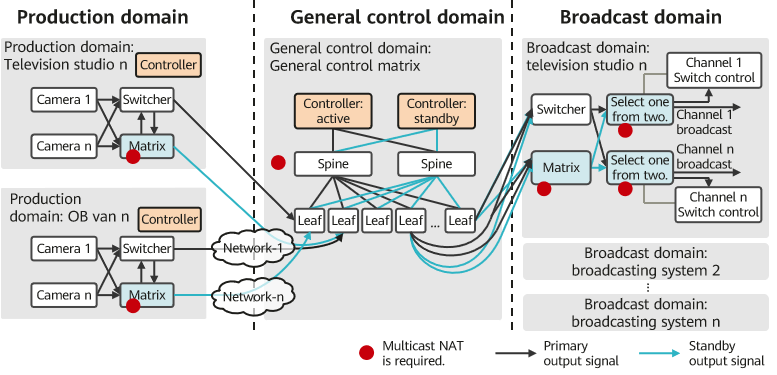
IP-based production and broadcasting network
Basic Architecture of the IP-based Production and Broadcasting Network
- The bottom layer is the media node layer, which consists of media asset terminals responsible for signal processing, monitoring, synchronization, production, etc.
- The middle layer is the core network layer. Media asset terminals located in the bottom layer are connected to the IP-based switching matrix in the middle layer through optical fibers or network cables. The IP-based switching matrix uses the spine-leaf networking architecture.
- The top layer is the comprehensive management layer, which includes the SDN controller of a media asset vendor. The controller manages and controls the IP-based switching matrix and media asset terminals through APIs to implement network management, network monitoring, IP flow analysis, and intelligent scheduling.
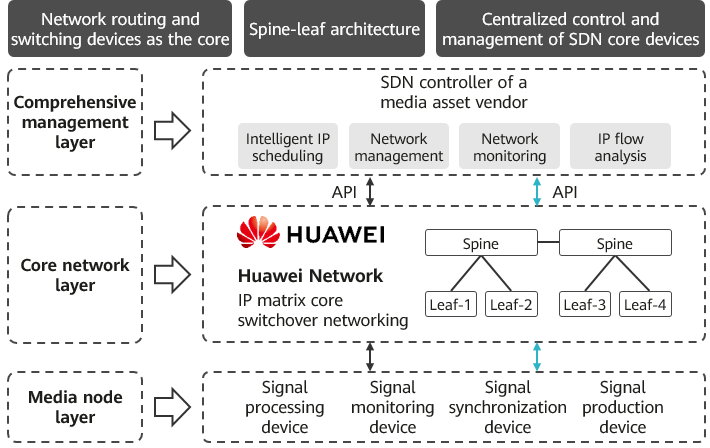
SDN architecture of Huawei's Intelligent IP Production and Broadcasting Network Solution
- Efficient forwarding: The flattened design shortens the communication path between media nodes, effectively reducing the delay.
- Load balancing: The spine-leaf architecture allows all links on the entire network to be used and load balancing to be implemented in a loop-free environment. This equal-cost multi-path (ECMP) design is optimal when a centralized network management platform, such as SDN, is used.
- Flexible capacity expansion: The bandwidth of spine nodes can be easily expanded by only adding spine nodes to provide the load balancing capability. Likewise, connections at the access layer can be easily increased by only adding leaf nodes.
- Non-blocking performance: Leaf nodes process connections at the access layer. Spine nodes ensure non-blocking performance with very low latency between any two ports, implementing agile services from media nodes to other media nodes and to the cloud.
- Single-node architecture: A spine node also functions as a leaf node. The networking is simple, and the cost is low. However, the system scalability is limited. As a result, this architecture applies only to small-scale control systems.
- Single-spine and multi-leaf architecture: Leaf nodes can be added to increase the network access capability. The forwarding capacity and entry capacity of the spine node determine the scale of the entire network. This architecture has good scalability and is suitable for medium- and large-sized control systems, meeting the requirements of most TV stations.
- Multi-spine and multi-leaf architecture: Horizontal expansion of spine and leaf nodes can be implemented at the same time. The system can provide the capacity of multiple spine nodes. This architecture has the highest scalability and is suitable for ultra-large control systems.
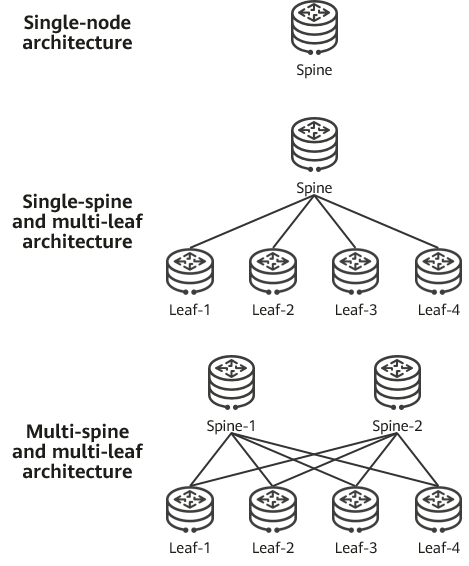
Spine-leaf networking architectures
In the spine-leaf networking architectures, routers with large-capacity line cards that support smooth evolution are used. The large-scale IP-based switching matrix system can transmit N x 2000 or N x 4000 channels of 4K uncompressed signals without blocking. Signals can be switched per flow or by group, facilitating service design. In addition, input, output, and preset rules can be delivered in batches, with a 10- to 20-fold increase in the delivery rate, rapidly meeting the requirements of large-scale switching. With the SDN controller that plans E2E network paths, non-blocking scheduling of omnimedia signals in scenarios with mixed unicast and multicast services can be implemented.
Furthermore, in the traditional production and broadcasting architecture, compressed signals are transmitted separately from uncompressed signals. The former are transmitted by IP network devices, and the latter are transmitted by the SDI switching matrix. In spine-leaf networking architectures, the IP-based switching matrix is used to transmit both compressed and uncompressed signals in a unified manner, simplifying the network structure.
Key Technologies Used on the IP-based Production and Broadcasting Network
Multicast NAT
- Traffic policies are applied to the inbound interface (Interface1) to match the source MAC address, source IP address, destination IP address, source UDP port number, and destination UDP port number of Stream-In. The traffic behavior is to associate the stream with a multicast NAT instance. The mapping between Stream-In and the multicast NAT instance is established based on the traffic policies.
- A multicast stream translation rule can be configured on outbound interfaces (Interface2 and Interface3) for them to translate some characteristics of output streams and bind the streams to a multicast NAT instance. The input and output multicast streams can be associated through a multicast instance.
- Each multicast NAT instance can be bound to multiple outbound interfaces. This allows one input multicast stream to be replicated to multiple outbound interfaces.
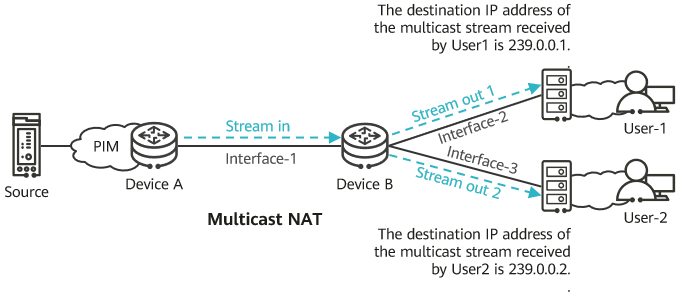
Multicast NAT
Huawei's Intelligent IP Production and Broadcasting Network Solution uses large-capacity multicast NAT to meet the requirements for unified transmission of multiple services by the ultra-large-scale matrix.
Clean Switching
Video switching refers to the process of switching from one video signal source to another instantaneously. Examples of this include switching between video sources output by multiple cameras in the production domain and between video sources of multiple programs in the broadcast domain. When video switching is performed, one picture is quickly switched to another on the TV screen. The basic requirements of video switching on the production and broadcasting network are frame precision, clean switching, frame synchronization for output signals before and after switching, and no picture damage. Clean switching aims to ensure that no black screen, artifact, or frame freezing occurs after the receiver obtains video signals during the switching between two video streams. The basic clean switching process is as follows:
- Input multicast stream 1 is matched based on two-level traffic policies on interface 1. The level-1 traffic policy matches the source MAC address of input multicast stream 1, and the traffic behavior is associated with the level-2 traffic policy. The level-2 traffic policy matches the source IP address, destination IP address, and UDP port number of input multicast stream 1, and the traffic behavior is associated with a multicast NAT instance. The mapping between input multicast stream 1 and the multicast instance is established through the two-level traffic policies.
- Input multicast stream 2 is matched based on two-level traffic policies on interface 2. The level-1 traffic policy matches the source MAC address of input multicast stream 2, and the traffic behavior is associated with the level-2 traffic policy. The level-2 traffic policy matches the source IP address, destination IP address, and UDP port number of input multicast stream 2, and the traffic behavior is associated with a multicast NAT instance. The mapping between input multicast stream 2 and the multicast instance is established through the two-level traffic policies.
- Multicast stream translation rules are configured on a specified outbound interface (interface 3) to either translate or not translate some characteristics of output multicast stream 1 and to bind output multicast stream 1 to the multicast NAT instance. Input multicast stream 1 and output multicast stream 1 can be associated through the multicast instance.
- After receiving a clean switching instruction from the controller, Device unbinds output multicast stream 1 from the multicast NAT instance, and binds output multicast stream 2 to the multicast NAT instance. This implements clean switching.
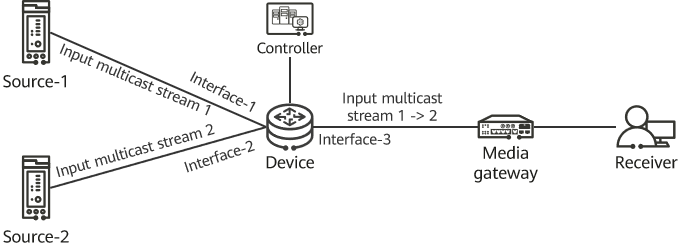
Clean switching
Huawei's intelligent IP Production and Broadcasting Network Solution uses the innovative network processor (NP) module and clean switching algorithm, and employs full-frame switching instead of traditional packet switching, thereby ensuring instantaneous and lossless switching of each video frame. This solution leverages the IP-based switching matrix and is decoupled from front-end and back-end peripheral devices without requiring double bandwidth. In addition, this solution complies with the ST2022 and ST2110 protocols and can adapt to multiple audio and video formats, such as Standard Definition (SD), High Definition (HD), and UHD.
High-Precision Clock
The IP-based production and broadcasting network has strict requirements on clock synchronization. In the traditional SDI architecture, clock synchronization on the production and broadcasting network is implemented by digital synchronizers. Black field signals and the three-level technique are used for precise clock synchronization to implement frame alignment and ensure image stability and lip synchronization. Clock synchronization of the entire TV station system is critical in the IP-based production and broadcasting network, which is why the Precision Time Protocol (PTP) is used. The clock synchronization system that is based on the Precision Time Protocol (PTP) can solve this problem. PTP is a master/slave synchronization system that uses the master/slave clock mode to encode time information and uses the network symmetry and delay measurement technologies to synchronize master and slave time. During system synchronization, the master clock periodically advertises the PTP time synchronization protocol and time information. Based on the timestamp information that the slave clock port receives from the master clock port, the system calculates the time delay and time difference between the primary and secondary lines. The time difference is then used to adjust the local time so that the frequency and phase of the slave device are consistent with those of the master device.

High-precision clock
Huawei's Intelligent IP Production and Broadcasting Network Solution uses the 1588v2 technology (also known as PTP) to implement clock synchronization. 1588v2 has the highest PTP clock precision (less than 10 ns) in the industry and allows the general control domain to provide clock signals for the entire TV station. In addition, algorithms such as Packet Timing Signal Fail (PTSF) are developed for IP-based production and broadcasting networks. These algorithms can be used to determine whether a clock source changes occasionally or continuously. The clock source is switched only if the clock source changes continuously, thereby ensuring clock stability.
Flow Recognition
During video production and live broadcast, switching between multiple video sources or cameras needs to be performed to achieve the optimal video display effect. Currently, IGMP is used to switch between different multicast groups. When IGMP starts or stops multicast forwarding, it does not determine the frame boundary of a video. As a result, the forwarded content does not form a complete picture, and the video does not meet the requirements of no artifact, jitter, black screen, or static frame. Flow recognition enables a device to collect statistics about the upstream traffic — for example, the numbers of packets and bytes — on an interface based on seven key fields of information (source and destination MAC addresses, source and destination IP addresses, source and destination port numbers, and protocol type) and send the statistics to a controller. On an IP-based production and broadcasting network, the flow recognition technology can identify audio and video streams, quickly and accurately copy and broadcast the identified streams, and guide the switching of these streams between multiple video sources or cameras to achieve the optimal video display effect.
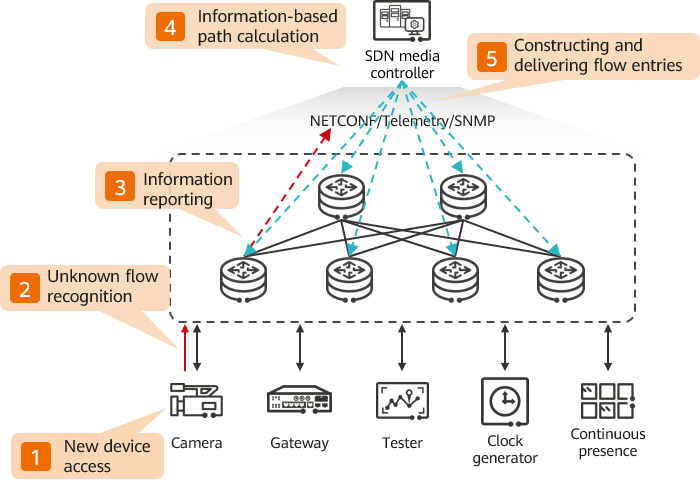
Flow recognition
Huawei's Intelligent IP Production and Broadcasting Network Solution uses a unique mechanism for automatically discovering, identifying, and reporting new streams. This mechanism eliminates manual misoperations and automatically identifies unauthorized attacks, reducing the amount of manual workload.
Security Attack Defense
Huawei's Intelligent IP Production and Broadcasting Network Solution provides comprehensive security attack defense to ensure the secure and stable running of the IP-based switching matrix. The details are as follows:
- Zero protocol, no address, and no attack surface: The implementation does not depend on protocols, no IP address needs to be configured for service interfaces, and the system provides no attack target externally. By default, Layer 2 and Layer 3 traffic is not forwarded, preventing insecure traffic from being spread through the system.
- Device security admission: Network devices accept flows only from authorized sources and send flows only to authorized destinations based on trustlists.
- Flexible traffic control: The bandwidth occupied by each flow can be limited. Different priorities can be specified for different flows to ensure the transmission quality of high-priority flows.
- Clock validity identification: Only valid clock packets are processed, and invalid ones are discarded. This prevents clock synchronization precision from being affected by PTP interference packets.
Successful Application of the IP-based Production and Broadcasting Network
Huawei works with many partners in the industry. In addition to joint innovation with TV station customers, Huawei has established partnerships with mainstream broadcasting and TV vendors to provide optimal E2E integration solutions. Huawei has also collaborated with standards organizations and industry alliances to further the development and market promotion of UHD standards.
Under the guidance of the Publicity Department of the CPC Central Committee, CCTV, Huawei, and other vendors have carried out a series of explorations on the IP-based production and broadcasting network based on the national key lab for ultra-HD audio and video presentation approved by the Ministry of Science and Technology. The IP-based production and broadcasting network has been successfully applied in important events such as China International Import Expo (CIIE), CCTV Spring Festival Gala, and Beijing Winter Olympic Games.
4K IP Television Television Studio Production System
- The control, management, and monitoring system resides at the upper layer. Oriented to O&M personnel of television studios and the general control system, this layer is mainly used to manage, monitor, and control the IP-based switching matrix, for example, to monitor the overall running status of the IP-based switching matrix. It provides convenient crosspoint interfaces for service switching and monitors the clock of the entire system.
- Various audio and video terminals of broadcasting and television vendors reside at the lower layer. Different types of devices and network nodes are connected through protocols to implement interworking.
- The IP-based switching matrix resides at the middle layer, which is the core hub for connections on the IP-based production and broadcasting network. This IP-based switching matrix opens northbound interfaces (including standard protocols such as NETCONF, telemetry, and SNMP) to the upper-layer control, management, and monitoring system to provide important information such as real-time running information of the IP-based switching matrix and clock synchronization information. It also receives service instructions such as creation, switchover, and deletion instructions from the upper-layer control, management, and monitoring system. Furthermore, the IP-based switching matrix has good interoperability with various lower-layer audio and video terminals of broadcasting and television vendors.
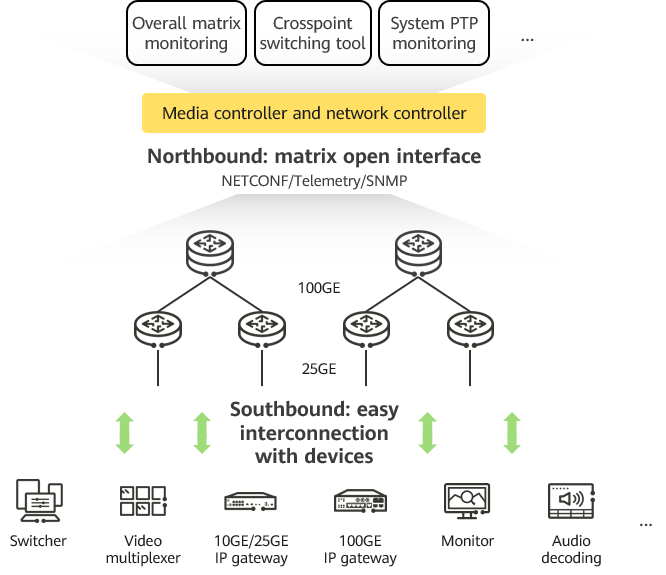
4K IP television studio production system
4K UHD IP Scheduling and Distribution System in the General Control Room
The IP-based general control room is another important application direction of the IP-based production and broadcasting network. Huawei's Intelligent IP-based Production and Broadcasting Network Solution helped CMG build the first IP-based general control system in China. It is the first uncompressed signal production and broadcasting system implemented using the SDN architecture in China and the largest 4K/8K general control IP-based production and broadcasting network system in the world. This solution supports scheduling of more than 2000 channels of 4K uncompressed signals. The system uses 100GE bandwidth, works with optical transmission network (OTN) devices to support ultra-long-distance transmission, and provides remote/ultra-remote production and broadcasting capabilities.
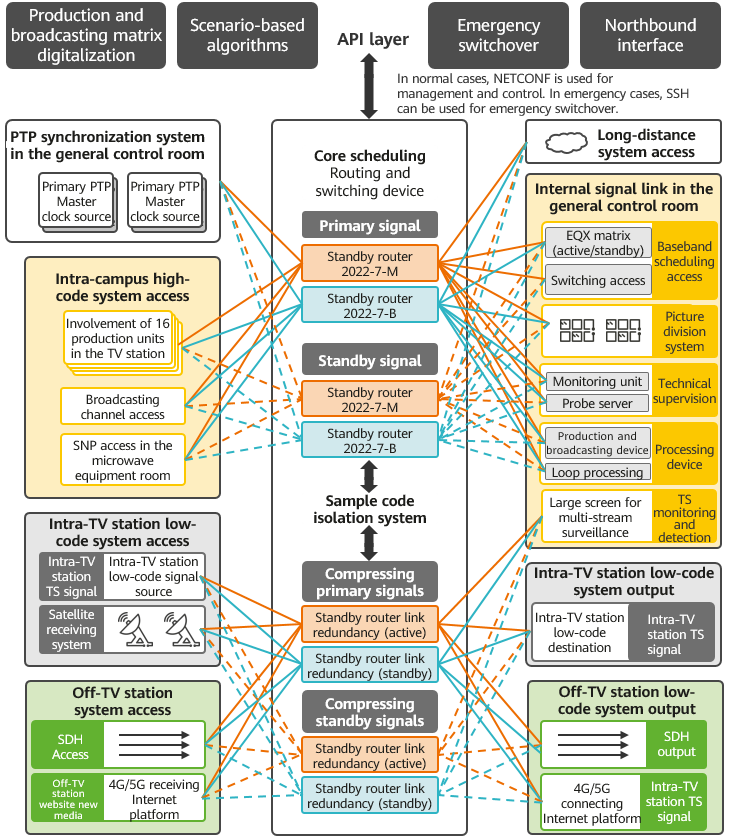
4K UHD IP scheduling and distribution system in the general control room
- Author: Chen Jingyi
- Updated on: 2023-05-23
- Views: 3717
- Average rating:







